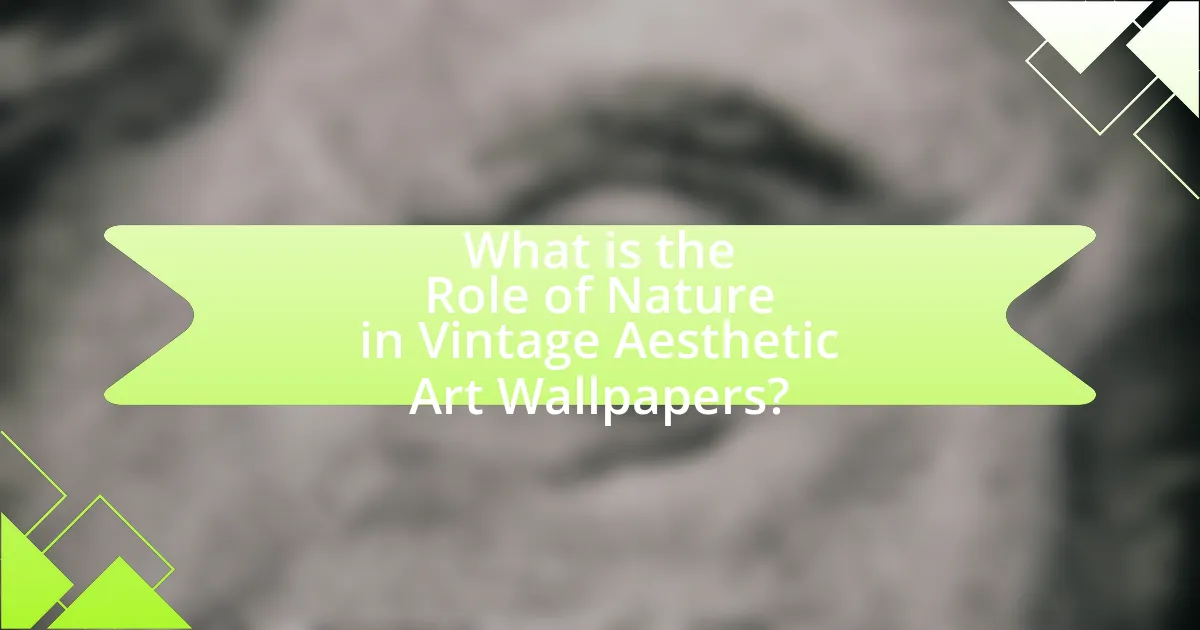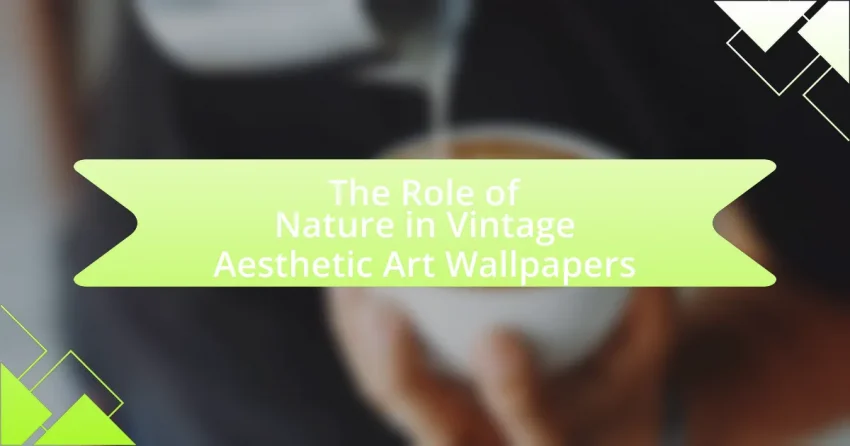The article examines the significant role of nature in vintage aesthetic art wallpapers, highlighting how natural elements serve as a primary source of inspiration and thematic content. It discusses the influence of historical movements, such as the Arts and Crafts movement, on the design of these wallpapers, which often feature botanical motifs, landscapes, and organic colors that evoke nostalgia and tranquility. The article also explores the characteristics of nature-themed vintage wallpapers, including common patterns, textures, and materials, as well as their impact on interior design and ambiance. Additionally, it provides guidance on incorporating these wallpapers into modern decor while emphasizing their benefits for creating calming and inviting spaces.

What is the Role of Nature in Vintage Aesthetic Art Wallpapers?
Nature plays a central role in vintage aesthetic art wallpapers by serving as a primary source of inspiration and thematic content. These wallpapers often feature botanical motifs, landscapes, and natural elements that evoke a sense of nostalgia and tranquility. The incorporation of nature reflects historical design trends, particularly from the Arts and Crafts movement in the late 19th and early 20th centuries, which emphasized craftsmanship and a connection to the natural world. This connection is further supported by the use of organic colors and patterns that mimic the beauty of flora and fauna, creating an immersive environment that enhances interior spaces.
How does nature influence the design of vintage aesthetic art wallpapers?
Nature significantly influences the design of vintage aesthetic art wallpapers by providing inspiration through its colors, patterns, and forms. Designers often draw from natural elements such as flora and fauna, incorporating intricate botanical illustrations and organic shapes that reflect the beauty of the natural world. Historical examples include the Arts and Crafts movement in the late 19th century, where artists like William Morris emphasized nature in their wallpaper designs, using motifs of leaves, flowers, and birds to create a harmonious connection between interior spaces and the outdoors. This approach not only enhances the visual appeal of wallpapers but also evokes a sense of tranquility and nostalgia, aligning with the vintage aesthetic.
What natural elements are commonly depicted in these wallpapers?
Natural elements commonly depicted in vintage aesthetic art wallpapers include flora, fauna, landscapes, and water features. These wallpapers often showcase intricate floral patterns, such as roses and lilies, alongside various animal motifs like birds and butterflies. Additionally, serene landscapes featuring mountains, forests, and rivers are prevalent, reflecting a connection to nature. The use of these elements serves to evoke a sense of tranquility and nostalgia, aligning with the vintage aesthetic.
How do color palettes inspired by nature enhance vintage wallpaper designs?
Color palettes inspired by nature enhance vintage wallpaper designs by creating a harmonious and organic aesthetic that resonates with historical themes. These palettes often incorporate earthy tones, such as greens, browns, and soft blues, which evoke the tranquility and beauty of natural landscapes. For instance, the use of botanical motifs in vintage wallpaper, combined with colors drawn from flora and fauna, not only reflects the natural world but also aligns with the Arts and Crafts movement of the late 19th century, which emphasized craftsmanship and the beauty of nature. This connection to nature in color choices fosters a sense of nostalgia and warmth, making vintage wallpaper designs more appealing and timeless.
Why is nature a significant theme in vintage aesthetic art?
Nature is a significant theme in vintage aesthetic art because it embodies a sense of nostalgia and tranquility that resonates with viewers. This artistic movement often reflects a romanticized view of the natural world, emphasizing its beauty and serenity, which contrasts with the industrialization of the early 20th century. Historical context shows that artists sought to escape the chaos of modern life by depicting idyllic landscapes, flora, and fauna, creating a visual retreat for the audience. The prevalence of nature in vintage aesthetic art is evidenced by the popularity of botanical illustrations and pastoral scenes in art and wallpaper designs from that era, which served to evoke a simpler, more harmonious existence.
What historical movements have embraced nature in art and design?
Historical movements that have embraced nature in art and design include Romanticism, Impressionism, and Art Nouveau. Romanticism, which emerged in the late 18th century, emphasized emotional expression and the beauty of nature, as seen in the works of artists like Caspar David Friedrich. Impressionism, developed in the late 19th century, focused on capturing the effects of light and atmosphere in natural settings, with artists such as Claude Monet showcasing landscapes. Art Nouveau, popular from the late 19th to early 20th centuries, integrated organic forms and natural motifs into design, as exemplified by the works of Alphonse Mucha. Each of these movements significantly highlighted nature’s influence in their artistic expressions and designs.
How does the representation of nature reflect cultural values in vintage aesthetics?
The representation of nature in vintage aesthetics reflects cultural values by emphasizing harmony, nostalgia, and a connection to simpler times. This aesthetic often showcases idyllic landscapes, floral patterns, and natural motifs that resonate with a longing for the past, highlighting a cultural appreciation for the beauty and tranquility of the natural world. For instance, the Arts and Crafts movement in the late 19th century celebrated handcrafted designs inspired by nature, promoting values of craftsmanship and environmental consciousness. Such representations serve as a visual language that communicates societal ideals, reinforcing the importance of nature in cultural identity and heritage.
What are the characteristics of vintage aesthetic art wallpapers featuring nature?
Vintage aesthetic art wallpapers featuring nature are characterized by intricate botanical patterns, muted color palettes, and a nostalgic design style that evokes a sense of tranquility and connection to the natural world. These wallpapers often showcase detailed illustrations of flora and fauna, reflecting the artistic movements of the late 19th and early 20th centuries, such as Art Nouveau, which emphasized organic forms and natural motifs. The use of soft, faded colors enhances the vintage feel, while the repetitive patterns create a harmonious and immersive environment. Historical examples, such as those produced by William Morris, demonstrate the enduring appeal of nature-inspired designs in wallpaper art, reinforcing their significance in vintage aesthetics.
What styles and patterns are prevalent in nature-themed vintage wallpapers?
Nature-themed vintage wallpapers predominantly feature styles such as Art Nouveau, Arts and Crafts, and botanical illustrations. Art Nouveau is characterized by its flowing lines and organic forms, often depicting flowers, leaves, and vines in intricate patterns. The Arts and Crafts movement emphasizes handcrafted designs with natural motifs, showcasing flora and fauna in a more rustic and textured manner. Botanical illustrations, often inspired by scientific studies, present detailed and realistic representations of plants and flowers, reflecting the Victorian fascination with nature. These styles collectively highlight the beauty of the natural world, making them timeless choices in vintage wallpaper design.
How do textures and materials contribute to the vintage aesthetic of nature wallpapers?
Textures and materials significantly enhance the vintage aesthetic of nature wallpapers by evoking a sense of nostalgia and authenticity. The use of natural fibers, such as linen or cotton, creates a tactile quality that reflects traditional craftsmanship, while textured finishes, like matte or distressed surfaces, mimic the aged look of vintage prints. Historical wallpaper designs often feature botanical motifs and earthy color palettes, which are further accentuated by the choice of materials that age gracefully over time. For instance, wallpapers printed with water-based inks on recycled paper not only contribute to an eco-friendly approach but also resonate with the vintage ethos of sustainability. This combination of textures and materials ultimately reinforces the timeless appeal of nature-themed wallpapers, making them a popular choice for those seeking to create a vintage-inspired interior.
How can one incorporate nature-themed vintage aesthetic art wallpapers into modern decor?
To incorporate nature-themed vintage aesthetic art wallpapers into modern decor, one can select wallpapers that feature botanical prints or landscapes, which harmonize with contemporary design elements. This approach allows for a blend of old and new, creating a cohesive aesthetic. For instance, pairing a vintage floral wallpaper with minimalist furniture can enhance the room’s character while maintaining a modern feel. Additionally, using wallpapers as accent walls in spaces like living rooms or bedrooms can draw attention to the vintage art without overwhelming the modern decor. The contrast between the intricate vintage designs and sleek modern furnishings can create a visually appealing environment that celebrates both styles.
What are the benefits of using nature-inspired vintage wallpapers in interior design?
Nature-inspired vintage wallpapers enhance interior design by creating a calming and inviting atmosphere. These wallpapers often feature botanical motifs and natural landscapes, which can evoke feelings of tranquility and connection to the outdoors. Research indicates that incorporating elements of nature into living spaces can reduce stress and improve overall well-being, as supported by studies from the University of Queensland that show exposure to nature can enhance mood and cognitive function. Additionally, vintage wallpapers add character and historical depth to a space, making it unique and aesthetically pleasing. The use of these designs can also reflect sustainability, as many vintage wallpapers are made from eco-friendly materials, aligning with contemporary values of environmental consciousness.
How can nature-themed wallpapers enhance the ambiance of a space?
Nature-themed wallpapers enhance the ambiance of a space by creating a calming and inviting atmosphere that connects occupants to the natural world. These wallpapers often feature serene landscapes, botanical patterns, or wildlife imagery, which can evoke feelings of tranquility and relaxation. Research indicates that exposure to nature, even in visual forms, can reduce stress and improve mood, as demonstrated in a study published in the Journal of Environmental Psychology, where participants reported lower stress levels in environments with nature imagery compared to those without. By incorporating nature-themed wallpapers, spaces can foster a sense of peace and well-being, making them more enjoyable and conducive to relaxation or productivity.
What tips can help in selecting the right nature-inspired vintage wallpaper for a room?
To select the right nature-inspired vintage wallpaper for a room, consider the color palette, pattern scale, and overall theme. A harmonious color palette that complements existing decor enhances the room’s aesthetic; for instance, earthy tones like greens and browns evoke a natural feel. The scale of the pattern should match the room size; larger patterns can overwhelm small spaces, while smaller patterns may get lost in larger rooms. Additionally, ensure the wallpaper’s theme aligns with the desired ambiance; botanical prints can create a serene atmosphere, while wildlife motifs may add a touch of whimsy. These considerations are supported by design principles that emphasize balance and cohesion in interior spaces.
